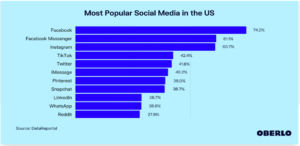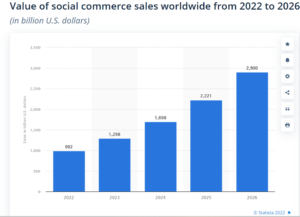
For the past five or so years, eCommerce sellers have been seeing great results from their social media activity, driving revenue by offering discounts with smart ad targeting, nurturing relationships with potentially interested customers, and by focusing on customer engagement with discounts and upsells. Selling on social media has been more or less elusive.
Mainstream social networks have been known to misread consumer interest in shopping while scrolling through the newsfeed. As of 2017, social commerce was only driving about 2% of retail sales, but as our attention turns to our 2023 strategies, there’s plenty of reason to believe that social commerce is about to turn another major corner.
Most retail executives worldwide have experimented with social commerce buttons – that’s more than kiosks or catalogs, mind you, even if it’s nowhere near the adoption rates of eCommerce websites.

And even if social commerce is small compared to other retail channels, its growth has been dramatic, jumping 600% from $5 billion in 2011 to $30 billion in 2015. And it’s continuing to grow. In 2022, Global sales via social media platforms were estimated at 992 billion U.S. dollars. The estimations are that by 2026, social eCommerce sales will reach 2.9 trillion U.S.
If you’re a business owner, don’t wait too long to integrate social commerce into your strategy, and you’ll be wishing you’d done so sooner.

Here are three platforms to focus your social commerce efforts on in the coming year.
Messenger Bots for Automated Conversational Selling
Facebook is still the king and most popular social network worldwide, and 4.7 billion people actively use its companion messaging app every month. In recent years, it’s been installed on more smartphones than Facebook itself. Your customers are more than likely already using Messenger to connect with their friends, family, and favorite brands, so why not use it to build an automated interactive shopping experience, which you can also use to follow up with customer service and support?
You can use third-party tools to build a chatbot that asks people what they’re looking for and, based on their answers, lead them through a customized shopping experience that ends with checkout, courtesy of the support for payments from directly within Messenger.
After the order is placed, customers can also opt to receive shipping updates via push notification, which helps them to keep an eye on their orders until they make it to the door. And, you could even add AI to deliver a more personalized experience.
Using message triggers, you can let your customers know when something they’re interested in is on sale, provide content assets to support their purchases, and even let them reach out to customer service if there’s an issue.
Shoppable Instagram for Lifestyle Imagery That Sells
Shoppable images are becoming increasingly popular on image-heavy networks like Instagram and Pinterest. It’s possible to make your images shoppable directly on Instagram, but if you’re busy selling on other channels and marketplaces as well, as many eCommerce merchants are nowadays, you also have the option to integrate it into your marketing, inventory, and fulfillment systems, all synced via BigCommerce.
Instagram limits users to a single clickable link in their bio, so shoppable tags make it easy for eCommerce retailers to get high-intent Instagram users to their stores. Prior to Instagram launching the shoppable posts feature earlier in 2018, sellers had to rely on third-party workaround services to link their posts to their online stores, and many major brands, such as Starbucks, were doing just that.
Shoppable posts mean that Instagram users can spot something they want to buy, click it, and be taken directly to the product page in the online store to view product information or make a purchase without ever needing to leave the Instagram app.
Amazon Spark for Shopping Under the Influence
In July 2017, Amazon Finds (AKA Amazon Spark) finally rolled out to Prime users, after much hype in the rumor mill. It’s a social feed of user-generated content, available as a section within the Amazon storefront app. Marketers can treat it like another Pinterest or Instagram since ‘Finds’ too is all about the visuals. But it comes with a few caveats.
Amazon knows its most active shoppers are Amazon Prime members, as they spend an average of $50 more per month, which translates to $600 more per year, than non-members. By 2025, the numbers can reach more than 176 million users.
Don’t Wait – Get in on the Ground Floor
Sure, it’s becoming mainstream to appear on social commerce platforms, and the quicker you act to get involved in it, the better off you’ll be when it hits the big time.
Your customers and prospects are already engaging with you on social channels, so adding the ability to make purchases directly from social channels enhances the user experience through added convenience.
